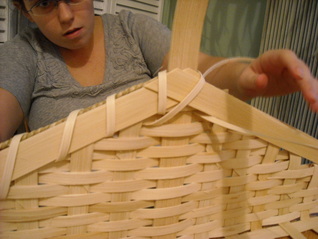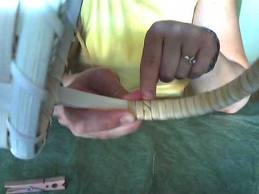When it comes to weaving baskets there are some terms and techniques you will need to familiarize yourself with. This page has most of the basket weaving terms and simple basket making techniques that you will need to get started making baskets.
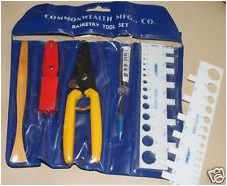
Tools
To start making baskets you will need a pan or pail for water, pinch clothespins, a yardstick, pencil, clippers or heavy scissors, an awl or small flat screwdriver, and a surform shaver. This is a great tool kit for beginners.
To start making baskets you will need a pan or pail for water, pinch clothespins, a yardstick, pencil, clippers or heavy scissors, an awl or small flat screwdriver, and a surform shaver. This is a great tool kit for beginners.
Soaking
Commercial reed needs to be soaked in warm water for about ten minutes. Ash, cherry and walnut need less soaking time.
Commercial reed needs to be soaked in warm water for about ten minutes. Ash, cherry and walnut need less soaking time.
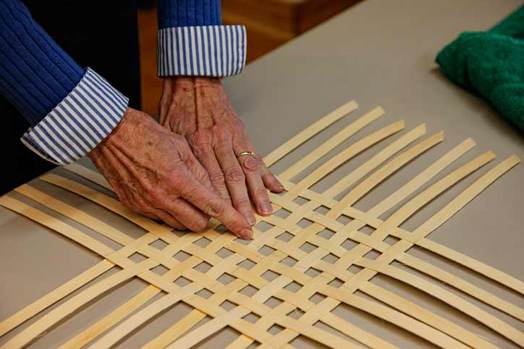
Laying Out the Base
Bases are laid out in a basic over 1/under 1 weave, each row being opposite its neighbor. Start with 3 x 3 spokes, centered, and grow to the required number of spokes for each basket's directions.
Measure the base for width and length, making sure spacing is even. Halve the measurements and measure from the center for more accuracy. Unless specified, bases are generally laid out rough side up with the center of the spokes marked on the rough side.
Bases are laid out in a basic over 1/under 1 weave, each row being opposite its neighbor. Start with 3 x 3 spokes, centered, and grow to the required number of spokes for each basket's directions.
Measure the base for width and length, making sure spacing is even. Halve the measurements and measure from the center for more accuracy. Unless specified, bases are generally laid out rough side up with the center of the spokes marked on the rough side.
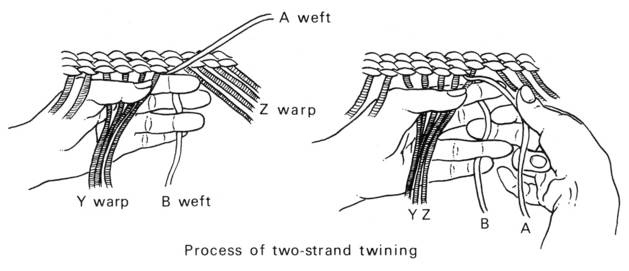
Twining
Twining is a weave normally using round reed. Use a long piece of the size specified (or use 2 pieces) and find the center. Give it a twist between your fingers (or crimp it with a needlenose pliers) and fold it in half. Hook it over a spoke and bring both ends out to the front.
Have the long ends going towards the right if you are right-handed, reverse for left. Take the top (or front) piece and put it behind the next spoke and back out to the front. Repeat until the correct number of rows is completed. Cut off ends on the inside.
Twining is a weave normally using round reed. Use a long piece of the size specified (or use 2 pieces) and find the center. Give it a twist between your fingers (or crimp it with a needlenose pliers) and fold it in half. Hook it over a spoke and bring both ends out to the front.
Have the long ends going towards the right if you are right-handed, reverse for left. Take the top (or front) piece and put it behind the next spoke and back out to the front. Repeat until the correct number of rows is completed. Cut off ends on the inside.
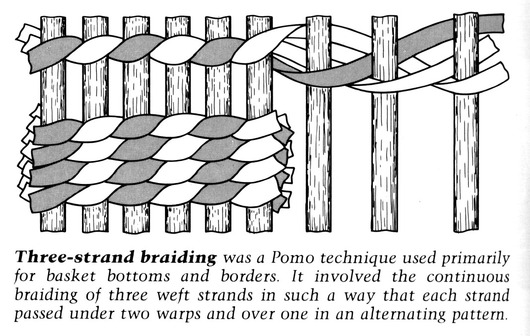
Triple Twining
Triple twining is twining with three pieces of round reed instead of two pieces. Use three pieces of reed starting: one behind one spoke, one behind the next (second) spoke to the right, and one behind the next (third) spoke to the right, with ends coming out to the front.
Take the piece farthest to the left and put it behind (and out to the front again) the fourth spoke. Take the piece now farthest to the left and put it behind the fifth spoke. Continue taking the weaver farthest to the left and weaving it behind the "next available spoke" - the one with nothing behind it yet. This twining is actually "over two, behind one."
Triple twining is twining with three pieces of round reed instead of two pieces. Use three pieces of reed starting: one behind one spoke, one behind the next (second) spoke to the right, and one behind the next (third) spoke to the right, with ends coming out to the front.
Take the piece farthest to the left and put it behind (and out to the front again) the fourth spoke. Take the piece now farthest to the left and put it behind the fifth spoke. Continue taking the weaver farthest to the left and weaving it behind the "next available spoke" - the one with nothing behind it yet. This twining is actually "over two, behind one."
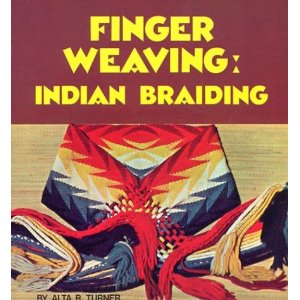
This is a great book for learning twining techniques
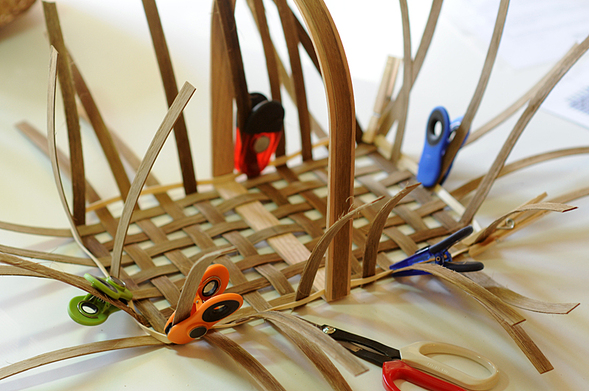
Upsett
To "upsett" means to gently bend up the spokes at the base perimeters. This just makes the upward weaving easier.
To "upsett" means to gently bend up the spokes at the base perimeters. This just makes the upward weaving easier.
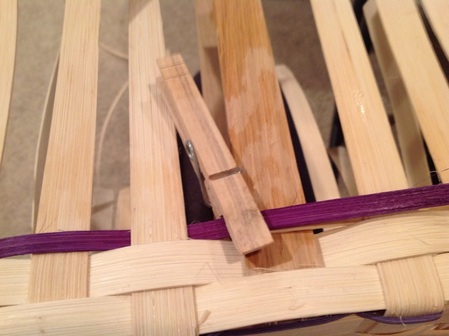
To Weave a Row
Unless specified, normal weaving is weaving one row at a time, over one/under one. Weave with the good side of the reed (smooth, less splintery side) towards the outside of the basket. Place the end of the reed on the outside of a spoke.
Weave all the way around - over one/under one - using lots of clothespins to hold it in place. The more clothespins you use, the better shaped basket you will get.
To finish a row, overlap your piece of reed by four spokes and cut it off. If woven correctly, both ends will be hidden. The end of the weaver will slip into weaving at the beginning of that same row.
If weaving with flat/oval reed, it is best to shave off the "oval" on the bottom piece, so that the area of overlap is not so bulky.
Consecutive rows are opposite the row before it (if over/under, then under/over). Be sure to rotate your basket so that all your stop/starts will not be on the same side. Try to start far enough to the left on each side, so that you don't have to "overlap by four" around a corner. Also be sure to pack down the rows as you weave so that there are no spaces showing between the rows of weaving.
Unless specified, normal weaving is weaving one row at a time, over one/under one. Weave with the good side of the reed (smooth, less splintery side) towards the outside of the basket. Place the end of the reed on the outside of a spoke.
Weave all the way around - over one/under one - using lots of clothespins to hold it in place. The more clothespins you use, the better shaped basket you will get.
To finish a row, overlap your piece of reed by four spokes and cut it off. If woven correctly, both ends will be hidden. The end of the weaver will slip into weaving at the beginning of that same row.
If weaving with flat/oval reed, it is best to shave off the "oval" on the bottom piece, so that the area of overlap is not so bulky.
Consecutive rows are opposite the row before it (if over/under, then under/over). Be sure to rotate your basket so that all your stop/starts will not be on the same side. Try to start far enough to the left on each side, so that you don't have to "overlap by four" around a corner. Also be sure to pack down the rows as you weave so that there are no spaces showing between the rows of weaving.
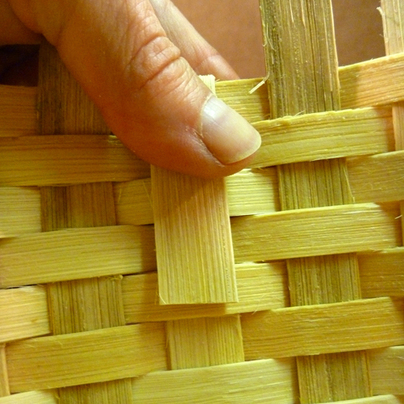
Fold and Tuck
Unless specified, you will fold and tuck the outside spokes. Fold from the outside, the end of a spoke and tuck it into a row (or rows) of weaving on the inside of the basket. It is best to fold it over, cut off any excess, and then tuck it in to get a clean finish. The inside spokes can be cut off with the top of the last row of weaving.
Unless specified, you will fold and tuck the outside spokes. Fold from the outside, the end of a spoke and tuck it into a row (or rows) of weaving on the inside of the basket. It is best to fold it over, cut off any excess, and then tuck it in to get a clean finish. The inside spokes can be cut off with the top of the last row of weaving.
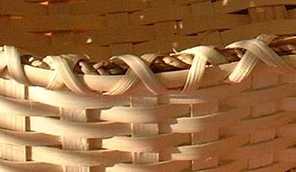
Wrap the Rim
To wrap the rim means to take two pieces of reed and wrap one around the inside and one around the outside of the rim, with a two to three inch overlap. Have the inside rim overlap on the opposite side that the outside ends do - and try to avoid overlapping rims at the handle. The rim covers the top row of weaving.
If flat/oval is being used, then both ends should be shaved down where they overlap (one on the top side/the other on the bottom side) so that they will lay down smoothly.
Rim filler is usually seagrass or round reed and lays between the two rim pieces to make a nice, clean finish to the rim.
To wrap the rim means to take two pieces of reed and wrap one around the inside and one around the outside of the rim, with a two to three inch overlap. Have the inside rim overlap on the opposite side that the outside ends do - and try to avoid overlapping rims at the handle. The rim covers the top row of weaving.
If flat/oval is being used, then both ends should be shaved down where they overlap (one on the top side/the other on the bottom side) so that they will lay down smoothly.
Rim filler is usually seagrass or round reed and lays between the two rim pieces to make a nice, clean finish to the rim.
|
Lashing the Rim
Using 1/4" flat or cane, lash the rim to the basket (this is a lot like sewing). Bury the ends by going under the inside rim and down the inside of your basket, under the weavers. Lash a "stitch" over the rim, coming out in between the rim and your second row of weaving. Remember - your rim is covering the top row of weaving. Make a “stitch" between every set of spokes. You will want to make an "X" at the handle. |
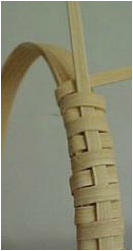
Wrapping the Handle
If you are using reed for the handle, you will want to wrap the handle with reed for a finished look. Start with a new piece of 1/4" flat, burying the end on the inside of the basket. Tightly wrap the handle with the 1/4" flat, each row snug to the row before it.
An "X" lashing can also be used: go across the handle one way, leaving space between each wrap around. Then turn around and come back across the handle, making an "X" each time.
Accent pieces of dyed 1/4" flat can be used to match the basket. Lay the end of the dyed piece under a few rows to secure it, then go over and under it to create a pattern as you wrap the handle.
If you are using reed for the handle, you will want to wrap the handle with reed for a finished look. Start with a new piece of 1/4" flat, burying the end on the inside of the basket. Tightly wrap the handle with the 1/4" flat, each row snug to the row before it.
An "X" lashing can also be used: go across the handle one way, leaving space between each wrap around. Then turn around and come back across the handle, making an "X" each time.
Accent pieces of dyed 1/4" flat can be used to match the basket. Lay the end of the dyed piece under a few rows to secure it, then go over and under it to create a pattern as you wrap the handle.
